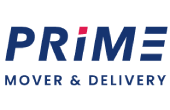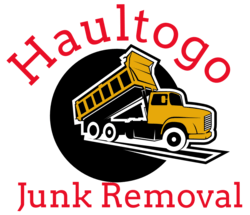How SEO-Friendly Website Design can help to improve your Small Business?
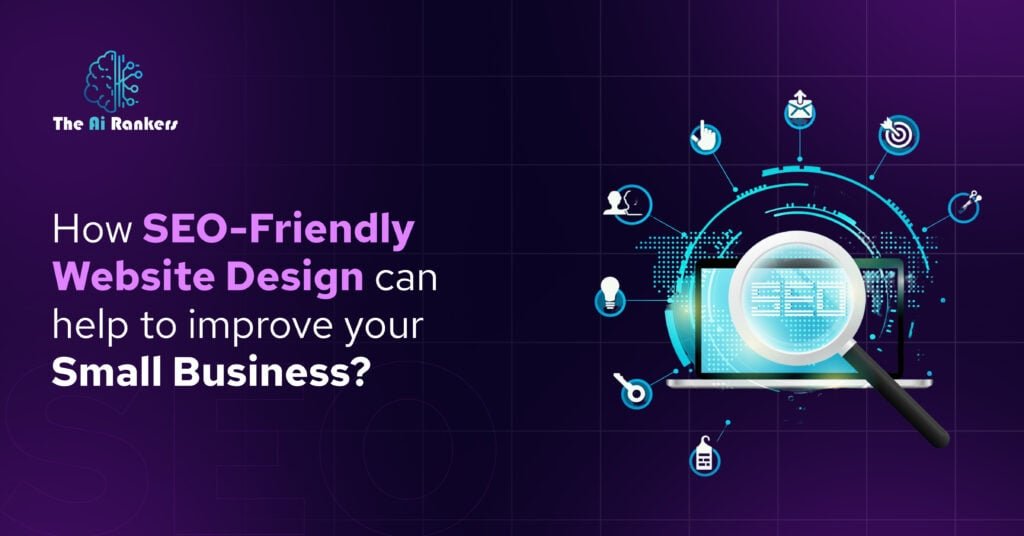
Introduction Small businesses in Austin TX need to have a strong web presence in today’s digital world. An SEO-friendly website design that not only brings in visitors but also turns them into devoted clients is the most important part of this presence. A well-designed website can make your business much more visible on search engines, which will bring in more visitors and help it grow. It is very important for small businesses all across the continent to know how to develop websites that are good for SEO. This post will go over some of the most important tactics and best practices that can help you make a website that stands out in the crowded online world. Learning about SEO-Friendly Website Design Website design that is good for SEO is about more than simply looks. It’s a way of doing things that makes search engine optimisation (SEO) a part of your website’s structure. This makes sure that your site looks good and is also optimised for search engines, which makes it easier for people who might want to buy from you to find you. An SEO-friendly design should have fast loading speeds, work well on mobile devices, and be easy to navigate. Small businesses can improve their search engine results and the experience of their users by focussing on these things. How important is it for pages to load quickly ? Speed is very important for both how users feel about your site and how well it ranks in search engines. Search engines give higher rankings to websites that load quickly because they want to provide users with a smooth experience. For small businesses, making sure that pages load quickly may make a big difference by lowering bounce rates and raising engagement. To get the fastest loading times, think about optimising images, using browser caching, and reducing HTTP requests. These technological changes can make your website work much better and show up more in search results. Responsive on mobile Having a mobile-friendly website is no longer a choice; it’s a must-have. More and more people are using smartphones and tablets. A design that works on mobile devices makes sure that your website looks well on all of them, giving users a consistent and easy-to-use experience. Google and other search engines put websites that are easy to use on mobile devices higher in their rankings. Adopting a mobile-first approach can help small businesses in Austin TX get more search prominence and reach more people. Easy to Use Navigation Navigation is an important part of website design that impacts how people use the site and how well it ranks in search engines. Visitors can easily discover the information they need with a navigation structure that makes sense. This cuts down on irritation and encourages longer visits to the site. A well-organised navigation menu can help people find their way around your site, which will increase user engagement and improve your site’s SEO performance. Make a navigation system that helps your company goals by using clear labels, logical categories, and a straightforward hierarchy. Best SEO Practices for Content When it comes to SEO, content is king. Not only does high-quality, relevant content bring in visitors, but it also tells search engines that your website is a good source of information. Here are some tips for writing content that is good for SEO: Finding and using keywords Any great SEO approach starts with good keyword research. Find out what words and phrases your target audience is using to search for things, and then use them in your content in a way that feels natural. This can help your website show up higher in search results for relevant queries, which will bring more focused visitors to your site. If you own a small business in Austin TX, using local keywords can help you show up more often in regional search results. Use tools like Google Keyword Planner to find keywords that are relevant to your business and will have a big impact. Making content that is interesting and useful To get people to look around your website more, you need to provide interesting material that grabs their attention. Make sure that the information you make is useful and well-organised and meets the requirements and interests of your target audience. Add images, videos, and infographics to your material to make it more interesting and useful. This not only makes the experience better for users, but it also makes it more likely that they will share your site on social media, which can make it more visible and trustworthy. Improving Meta Tags and Descriptions Meta tags and descriptions are very important for how search engines read and show your website in search results. Make sure that every page has a different title tag with lots of keywords and a meta description that appropriately describes what the page is about. For small businesses, improving these things will help you get more clicks and more visitors from search engines. Make your titles short and interesting, and utilise meta descriptions to give visitors a quick idea of what they can expect from your website. Using links from inside and outside of the site Links are an important aspect of SEO since they connect different portions of your website and the web as a whole. Internal links help spread page authority across your site, directing readers to related material and making their experience better. At the same time, links to trustworthy outside sources can make your site look more credible and authoritative. For small businesses, putting internal links in the right places helps retain visitors on their site longer. External links to trustworthy sites can also help with search engine visibility and trust. To get the most out of your linking strategy, choose anchor text that flows well with the content and is descriptive. Using Structured Data Markup Structured data markup is a great way to help search engines figure out what your website is about. Adding schema markup to your
Why is it important for your online business to have an SEO-friendly domain?
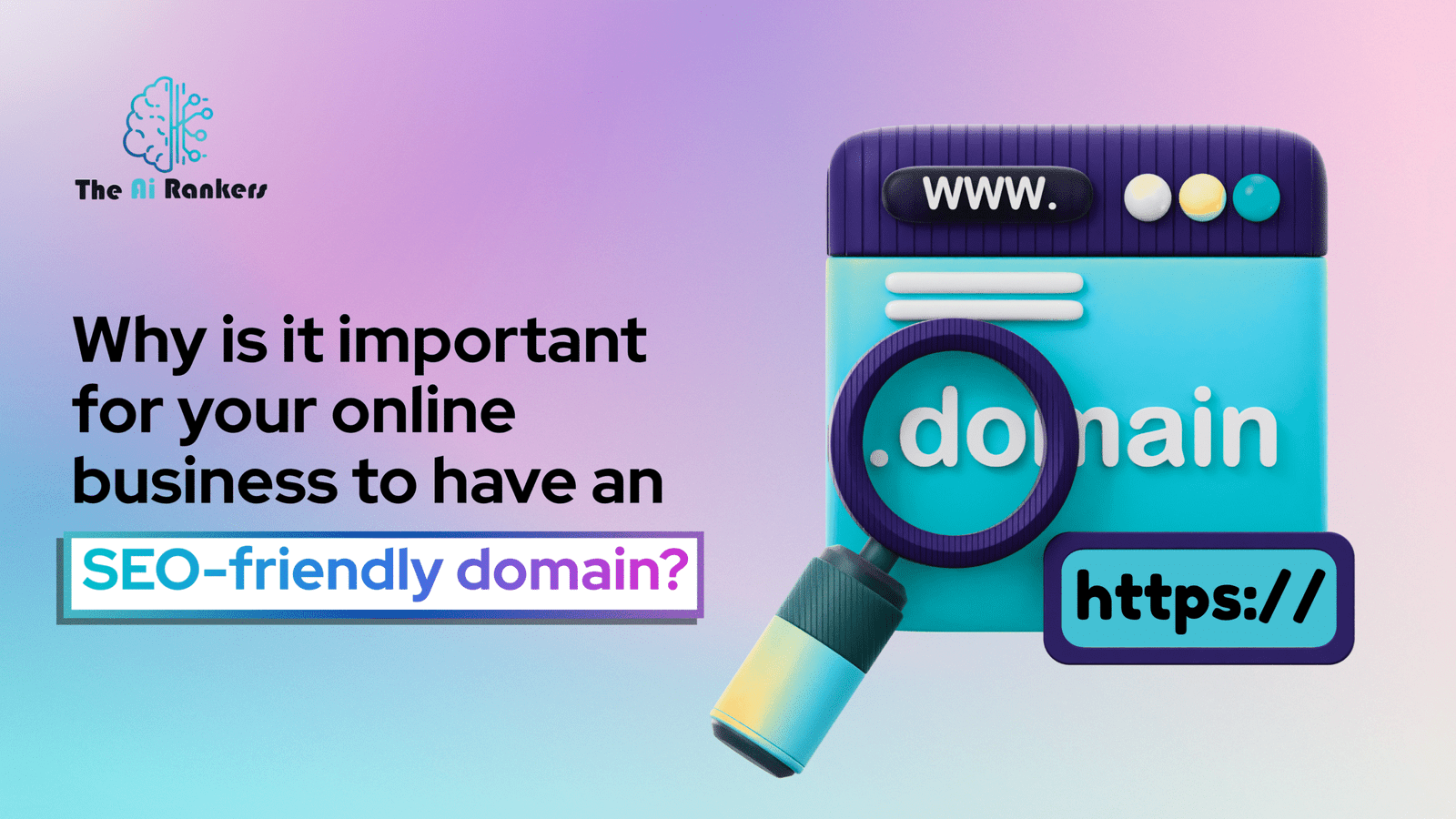
Picking a domain name is one of the most important things you need to do to start a website, but it’s also one of the most common things people forget to do. People often have trouble using their brand name or a word that has to do with the goods and services they offer. In addition, 500,000 new small businesses start up in the US every year, and 60% of them have a website. There is a lot of competition online, so someone else may already own the domain name you want. If you’re feeling stressed out and need help finding an SEO-friendly domain name, our SEO business can help a lot. We promise it’s not hard. Just keep it basic and don’t think too much about it, and you’ll find the ideal domain name. This blog will talk about different types of domain names, how to pick the best one for your site, and how your choice affects SEO. Let’s get going. We are a local SEO company in the US that offers a lot of different services, such as SEO, Google My Business (GMB), site design and redesign, and more. Is your domain name important for search engine optimization? Your domain name definitely has an effect on SEO. You want a domain name that gets a lot of traffic, demonstrates that your business is online, and helps your brand’s reputation, whether you’re attempting to buy a domain name that fits your brand or keywords. The Search Engine Journal also found that the first organic result on Google has a click-through rate of 28.5 percent. This means you need a full plan to boost your rankings. Your domain name’s SEO value isn’t the most important thing for raising your ranking score, but its overall effect may show how important it is. Let’s say you have a well-known brand or a domain name that matches what a user is looking for. In this case, it’s clear that your impressions and click-through rate will be high, which shows that search engines see your site as an essential and useful one. If you can choose a domain name that helps generate traffic to your site and keep it under control, you’ll see how it may have a good influence on all other parts of SEO, like a domino effect. The best way to choose a domain name You can choose a domain name that is focused on your brand or one that is optimised for keywords, as was said before. Each of these strategies has its own advantages, and some research might help you figure out which one is ideal for you. First, talk about these two options and pick the best SEO domain name for you. Domain Names for Branding and Advertising You may have noticed that most of the websites you visit use this method to choose a domain name for SEO. Your customers remember and recommend your brand. So, if they meet you in person or online, the first thing they’ll do is look up your company’s name. You have to utilise at least one domain name for your brand, no matter what. If you wish to use them or send them to another domain, you have to own them. A tiny number of well-known companies utilise domain names that are based on keywords. People acquire businesses because they know who they are and want to work with them. If Apple adopted the domain name worldbestsmartphone.com, do you think people would go on or search for apple.com? People trust your brand. This trust makes more people want to visit your site, read your material, and share it, which boosts your SEO reputation and rating. If you want a lot of clicks, here are several signs that you should use a branded domain name: Keywords in Domain Names When you look at SEO and how to choose a domain name, you might think that a domain name that is optimised for keywords is the ideal choice. In the end, keywords are an important part of every SEO strategy. When we talk about domain names, things are a little different. A keyword-based domain name, such floridahairstylist.com, includes both location and services. These domains, on the other hand, don’t have the company’s name on them. Instead, they tell the user what they do and where their business is located. You’re right that the keyword’s content is quite important because it says a lot about your business. Google, on the other hand, doesn’t trust domain names that are exact matches but don’t have a lot of keyword content on the site. We suggest mixing keywords with your brand if you’re sure you want to incorporate them in your domain. This will cover all your bases. Extent of Domain Name The length and size of your domain name don’t usually affect how well it ranks; it will show up in SERPs with all the other sites. On the other hand, if your domain name is long and hard to remember and type, you are much less likely to get direct traffic to your site. Geographical Viewpoint: Chosen Domain Extensions You should ask yourself if you would click on it to see if it is worth your time. You’re good to go if the response is yes. How do you choose a domain name that is good for SEO? Use domain extensions that are high-level Before you buy a domain, you need to decide if a domain extension is right for your business. There are almost 1,000 domain extensions available in practically every domain name system, which makes it quite hard to choose one. Experts believe that more than 49% of all domain names have the “.com” extension. You can also use standard domain extensions like “.org,” “.net,” “.info,” “.edu,” and so on. We still think that the .com domain extension is the best choice for building a blog, a business, or any other kind of profitable website. When someone first tells us the
Guide to Building Brand Awareness Through Digital Marketing
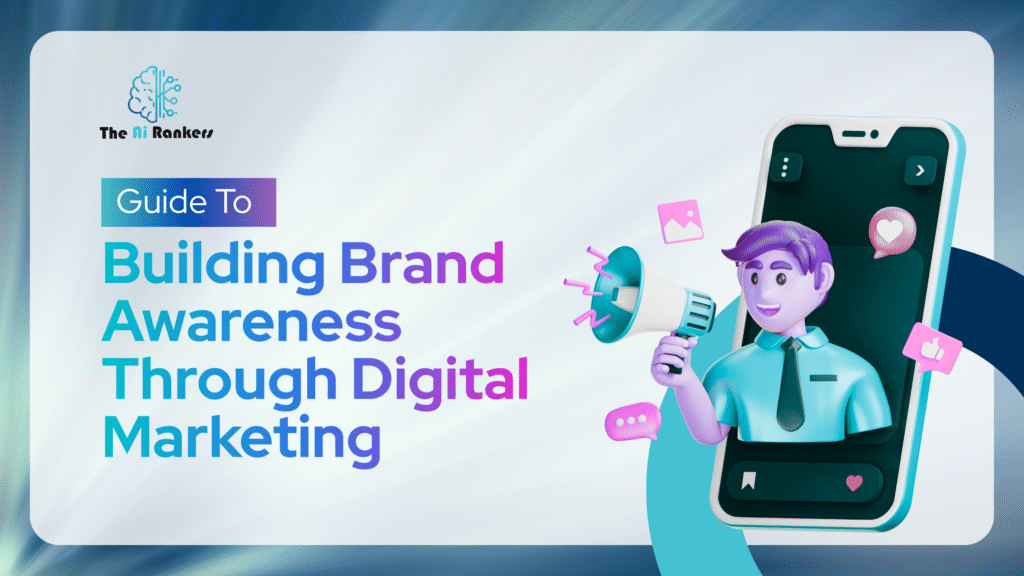
Standing out online feels a bit like trying to sing over a roaring jet engine: every day, your audience scrolls past more than 10,000 ads, posts, and push‑notifications. Yet some brands still burst through that noise, lodging themselves firmly in our memories, think Nike’s swoosh, Spotify’s wrapped playlists, or Wendy’s snarky tweets. Brand awareness is the alchemy behind that staying power. It’s the moment a shopper recognizes your logo before they can read your name, or the warm, fuzzy feeling a customer gets when your jingle plays on the radio. In this ultimate guide, we’ll unpack exactly how to engineer that magic with modern digital‑marketing tactics layer by layer, channel by channel, so your brand becomes both recognizable and unforgettable. What Is Brand Awareness? At its simplest, brand awareness is the degree to which your ideal customers recognize, remember, and trust your brand. Recognition is the surface layer, spotting your logo on a grocery shelf. Recall digs deeper, remembering your brand when no visual cue exists. Then comes resonance: an emotional connection so strong your brand becomes shorthand for an experience (think “Google it”). In the data age, awareness goes beyond mindshare; it affects click‑through rates, ad costs, and organic search volume. A highly recognized brand earns cheaper CPC bids, stronger SEO signals, and more user‑generated shout‑outs. But awareness is fragile. Misaligned visuals, inconsistent tone, or radio silence on social media can erode trust. Building and guarding brand awareness, therefore, requires deliberate, multi‑channel storytelling that aligns visuals, voice, and values at every digital touchpoint. Why It Matters A credible, well‑known brand acts like marketing jet fuel. First, trust and credibility: consumers gravitate toward brands they know, slashing decision friction at checkout. Second, customer loyalty: awareness fosters familiarity, and familiarity breeds repeat purchases and advocacy. Third, paid‑media efficiency: when users already recognize you, ad platforms reward higher engagement with lower CPCs. Finally, competitive moat: copycats may match your features or price, but brand equity built from awareness creates differentiation they can’t clone overnight. In other words, awareness is the soil from which all other marketing returns grow. Step‑by‑Step Digital‑Marketing Plan to Build Brand Awareness 1. Define Your Brand Identity Trying to build awareness without a clear identity is like promoting a concert before you’ve picked a genre. Start by distilling three pillars: Brand Voice – Are you playful like Innocent Drinks, authoritative like IBM, or rebellious like Harley‑Davidson? Audit current communications emails, social captions, and web copy to ensure they sound like one cohesive personality. Visual Identity – A style guide must codify colors, typography, iconography, and logo usage. Consistency here imprints your brand on visual memory pathways. Studies show cohesive color palettes boost brand recognition by up to 80 %. Unique Value Proposition (UVP) – In one sentence, explain why customers should care. “We deliver plant‑based meals in 15 minutes” beats “We sell healthy food.” Your UVP will anchor every campaign headline, meta description, and social bio. Action items: hold a half‑day workshop with stakeholders, create a mood board, craft a brand‑voice chart (tone, vocabulary, “never‑say” list), and bake these assets into a shareable brand kit. 2. Optimize Your Website for Brand Discovery Your website is the digital equivalent of a flagship store on Fifth Avenue. Every pixel signals identity. Begin with technical SEO: clean URL structures, schema markup for organization name/logo, and brand‑keyword meta titles (“Acme Widgets—Eco‑Friendly Home Gadgets”) to dominate branded SERPs. Next, craft a punchy hero section: one headline, one sub‑headline, and a CTA that echoes your UVP. Visitors should “get” your value within five seconds. Speed is brand perception. Google research shows that a one‑second delay slashes conversions by 20 %. Compress images with WebP, leverage browser caching, and lazy‑load below‑fold assets. Mobile‑first design is non‑negotiable—60 % of brand searches occur on phones. Use responsive breakpoints and thumb‑friendly navigation. Finally, weave storytelling into core pages. An “About Us” timeline adds human depth; customer testimonial sliders supply social proof. Integrate Google Search Console to track branded impressions and click‑through rates as an early awareness KPI. 3. Utilize Social Media Marketing Social platforms are modern‑day billboards, except they talk back. Select 2–3 networks where your audience already hangs out. For visual storytelling, Instagram Reels and Pinterest boards shine. For real‑time banter, Twitter (X) or Threads. For B2B thought leadership, LinkedIn. Create a content pillar matrix: for example, educational tips on Mondays, user‑generated spotlights on Wednesdays, and behind‑the‑scenes stories on Fridays. Consistency trains algorithms and audiences. Use scheduling tools (Buffer, Hootsuite) but stay human and reply to DMs, comments, and riff on trends within hours, not days. Micro‑influencer partnerships (<100 K followers) often outperform mega celebs in engagement. Provide them creative freedom within brand‑guideline guardrails and encourage authentic storytelling (“Day‑in‑my‑life with Brand X” beats scripted ad reads). Measure platform‑specific awareness: follower growth, reach, and share of voice (mentions vs. competitors). Iterate monthly; retire under‑performing post types, double down on hits. 4. Run Paid Advertising Campaigns Paid media is the espresso shot that jump‑starts awareness, but only if aligned with brand identity. On Google Ads, bid on not just your brand name but category keywords plus branded modifiers “eco‑friendly sneakers by [Brand].” Use responsive search ads to test headline variations: emotional hook vs. feature benefit. For social ads, design creative that mirrors organic posts, maintaining visual continuity. Retarget website visitors with sequential storytelling: Awareness Ad 1 introduces the mission; Consideration Ad 2 showcases testimonials; Conversion Ad 3 offers a limited‑time perk. YouTube bumper ads (6 seconds) work wonders for recall and focus on logo animation and UVP tagline. Allocate 60 % of the budget to awareness (top‑funnel) and 40 % to retargeting (mid‑/bottom‑funnel). Monitor view‑through conversions and incremental reach metrics to ensure ads aren’t just cannibalizing organic traffic. 5. Content Marketing: Blogs, Videos, Podcasts Content is the slow‑burn engine of brand authority. Start with keyword research around pain points your product solves; craft long‑form blogs answering those queries, weaving brand anecdotes naturally. Aim for skyscraper pieces (2,000+ words) to rank and gain backlinks. Video humanizes brands, whether it’s founder AMAs, product how‑tos, or customer success vignettes. To build visual
CMS vs Custom Website: Which is the Better Option for Your Business?
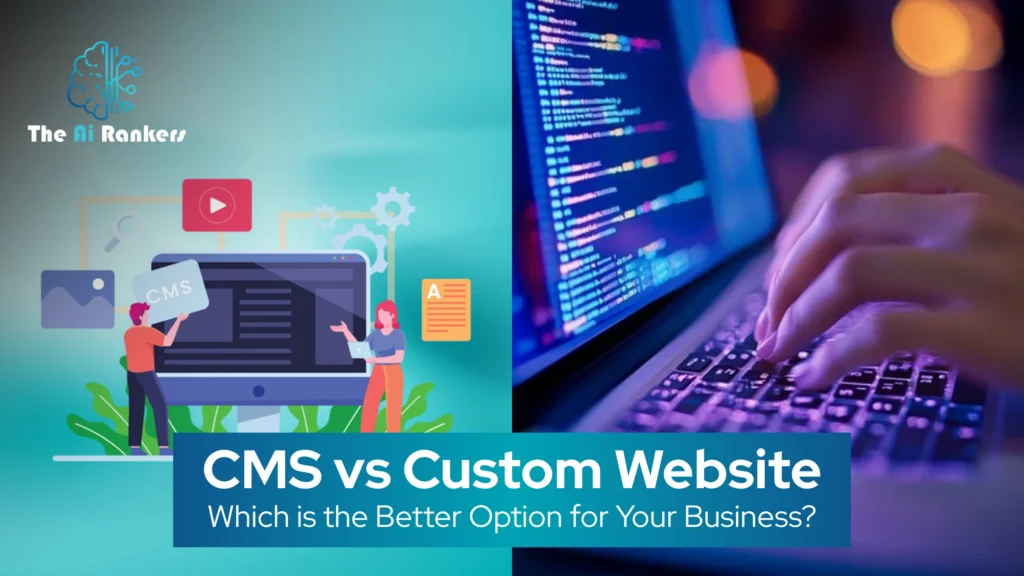
When it comes to building a website for your business, the choice between a Content Management System (CMS) and a custom-built website can feel like standing at a crossroads. Each path promises great things, but which one is the right fit for your needs? Well, let’s figure it out, have some fun along the way, so that you can decide which option gives you the best bang for your buck (and your time). By the end of this journey, you’ll know whether a CMS is your trusty sidekick or if a custom-built website is the superhero your brand deserves. What is a CMS? The Basics: What Does CMS Stand For? A Content Management System (CMS) is software that allows you to create, manage, and modify content on your website without the need for specialized technical knowledge. It’s like a digital toolbox, packed with easy-to-use tools that empower you to create and edit content at your convenience. Some of the most popular CMS platforms out there include WordPress, Joomla, and Drupal. These systems come with built-in themes, templates, and plugins, making it incredibly easy to launch a website, even if you’re not a tech wizard. How Does a CMS Work? Think of a CMS as a website’s engine, steering the car while you control the direction. It enables you to manage everything from your website’s design and structure to adding and updating content. Here’s a brief breakdown of how it works: In short, a CMS is for those who want a website up and running fast without the hassle of coding from scratch. What is a Custom Website? The Basics: Building from Scratch A custom-built website is a website that is designed and developed from the ground up specifically for your business. There are no pre-made themes or templates. Instead, everything is handcrafted to your exact specifications, making it truly unique. You get the freedom to create any design, feature, or functionality that fits your brand perfectly. Custom websites are typically built using coding languages like HTML, CSS, JavaScript, PHP, and more. You can choose to have the website created by an in-house team or hire a web development agency to bring your vision to life. How Does a Custom Website Work? With a custom-built website, you start with a clean slate. You or your developer can design the user interface, create the database, and integrate any features your business needs. There’s no need to conform to pre-set templates, so the possibilities are endless. Here’s a quick overview of how custom websites work: In essence, a custom website is the ultimate in flexibility and creativity, offering the most control and scalability for your business. CMS vs Custom Website: The Main Differences 1. Flexibility and Customization CMS: Limitations, But Quick Setup While CMS platforms come with a lot of pre-made themes, templates, and plugins, their flexibility can sometimes feel like being in a box. Sure, there’s a lot you can do, but you might find yourself working around certain constraints. Want a specific feature or functionality that isn’t available in the plugin marketplace? You may need to compromise or rely on third-party solutions. On the flip side, CMS platforms allow for quick setup. With pre-built templates and drag-and-drop editors, you can have a functional site up in no time without worrying about coding. So, if speed and convenience are your main concerns, a CMS could be the way to go. Custom Website: Full Creative Control When you opt for a custom website, you’re free to create something completely unique. No templates, no pre-set themes, just a website that’s 100% tailored to your needs. If you can dream it, developers can build it. Custom websites are perfect if you need a completely one-of-a-kind solution, offering you full control over design, functionality, and features. However, this kind of flexibility comes at a cost, both in time and money. Building a custom website from scratch can be time-consuming and expensive. It requires collaboration between designers, developers, and often other stakeholders, which can extend the timeline for launch. 2. Cost and Budgeting CMS: Low Initial Cost, High Maintenance Costs A CMS usually comes with a low initial cost. Most platforms like WordPress or Joomla are free to use, with premium themes and plugins costing extra. You can choose to host your website with low-cost hosting providers and maintain it on your own (if you’re comfortable doing so). In many cases, CMS platforms are highly affordable and perfect for small businesses or startups on a tight budget. However, as your business grows, the cost of maintaining a CMS website can increase. Premium plugins, advanced security features, and scaling infrastructure can add up over time. Additionally, CMS websites require regular updates, which can increase maintenance costs. Custom Website: Higher Initial Cost, Lower Maintenance Costs Custom websites generally come with a much higher upfront cost. The entire website needs to be designed, developed, and tested, and often requires ongoing maintenance, especially if you want to add new features. However, because you’re building everything from scratch, you don’t need to worry about third-party plugins or the restrictions of pre-built themes. If you already have a strong design concept and know exactly what you want, a custom website can be an investment that pays off in the long run. Once it’s built, ongoing maintenance is usually limited to things like server costs, security updates, and occasional tweaks. 3. Speed of Development CMS: Fast, Efficient, and Ready to Go If you need a website fast, CMS platforms are unbeatable. With ready-to-use templates, themes, and plugins, you can launch your website in a matter of days (or even hours). You don’t need to hire an entire development team—just pick your theme, install your plugins, and you’re good to go. However, there’s a catch. Because you’re relying on pre-made templates, you may face limitations in how customized your website can be. If you want specific features that aren’t available in the plugin marketplace, you might need to hire developers, which can increase the
Optimize Your Digital Presence from Our Expert SEO Services

Securing a high search engine position is crucial in today’s digital landscape, where millions of people use Google daily. Search engine exposure is an ever-present, round-the-clock requirement driven by keyword research. Whether someone is looking for a B2B software supplier, a great place for a family lunch, or just clothes, SEO ensures that your potential customers discover your business on the first go. Our professional team uses innovative SEO techniques to get your company to the top of SERPs (Search Engine Result Pages) for the most relevant keywords. We enable your company to grow significantly through a boosted online presence by utilizing these tried-and-true Search Engine Optimization strategies. An optimized online presence generates a consistent flow of leads and sales, allowing your business to boom among your competitors. What Does a Typical SEO Strategy Look Like: Keyword Research: Keyword Research holds the key to Search Engine Optimization of your brand. Imagine being in a library, searching for information on learning French more easily. You would most likely look for words like ‘French’, ‘Learn French,’ ‘French Language Made Easy,’ and maybe ‘French for Dummies.’ SEO key research is equally important in the same way but for digital search engines. Researching keywords for your website is like having a treasure map. It allows you to find the precise terms and phrases consumers use to search for products and services on search engines like Google. Using these precise keywords will make your business much more visible and eventually rank it much higher on Google. You can also make your content fit potential customers’ search terms if you understand relevant keywords. More people will be able to find your website with just a simple search, and those people will be more likely to be interested in your business. Our SEO services answer the consumer’s questions by speaking their language! In turn, it helps us connect you with your potential customers, who will inevitably drive your sales much higher than they currently are! Finding hidden keyword terms is as important as finding more common ones when researching. People may employ these supplementary keywords before they even know they need your service or product. To collect significant data on possible keywords, our SEO experts utilize complex tools such as Google Keyword Planner, SEMRush, and Ahrefs. With this data-driven strategy, we can identify the best keywords to target, ensuring that your website will be seen by its intended audience. On-Page Search Engine Optimization What makes on-page SEO so important? Think of it as preparing the stage for a perfect performance. In simpler words, On-Page SEO does the same job as an attractive window display to draw customers into the store. Prioritizing the most important pages on your website, such as the homepage, key categories, and landing pages, is the first step in developing an effective on-page search engine optimization campaign. Search engines will have an easier time understanding and ranking your website if you improve both the content and layout. This will result in higher visibility, leading to a rise in the number of visits and, ultimately, consumers for your company. The process of on-page optimization involves a great deal more than just updating page titles, meta descriptions, and on-page content. The content on your website must be strategically streamlined with the current market research trends of relevant main and ancillary keywords. Due to Google’s constantly evolving algorithms, your business’s on-page SEO must align with the updates. Our team of SEO on-page experts maximizes these features so that your website is recognized and highly ranked for its quality and relevance. BackLink Building Want to be featured on your favorite trusted website in your niche? Links from reputed websites are like personal recommendations. It not only vouches for your site but also increases the consumer’s trust and builds site credibility. Search engines like Google place a lot of weight on a website’s backlink profile when deciding how authoritative your site is. When determining the trustworthiness of your domain, they consider the relevancy and quality of the sites that connect to you. An example of a helpful backlink would be if a well-known food critic’s website is linked to your restaurant business. This is due to the fact that such a site possesses both a solid reputation and an abundance of high-quality links. Your site’s visibility in search results for food-related topics could be dramatically improved with just one link from such a reputable source. Earning links organically has replaced link buying as the key objective in current link-building SEO strategies. Manually submitting sites to internet directories was a common SEO strategy in the past, but it is no longer as successful. New websites might still benefit from directories, but connections from credible and relevant sites will have a far larger impact on your KPIs. Our SEO experts focus on producing interesting and useful content that provides consumers with unique insights and information. Our team also offers relationship-building with influencers and other businesses in your field to promote link earning. Google’s algorithms are sophisticated, but they use backlinks to determine authority, which scammers can easily manipulate. Spam websites and low-quality links can also often hurt your site’s organic reach and rankings. For these reasons, we always recommend that backlinks be best left to our experienced team, which can manage, optimize, and build your brand’s backlinks. Off-Page Search Engine Optimization Off-page SEO helps build trust in your site, just like good reviews and word-of-mouth can bring people to your physical location. These outside endorsements are seen as votes of trust by search engines like Google, which can help your site rank higher in search results. If you sell bespoke cakes, having your brand’s link on a wedding or event planner’s website would undeniably ensure the quality of your products. Backlinks work in a similar fashion, just like an endorsement from a well-established brand. The higher the trustworthiness and visibility of your endorser’s website, the more credible your own business looks. It also focuses on your target audience by making










